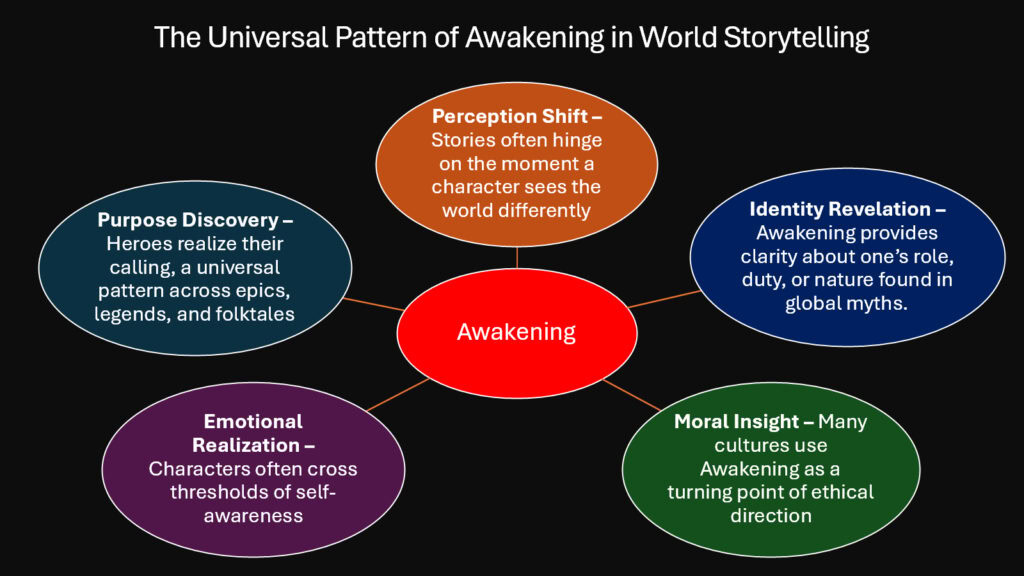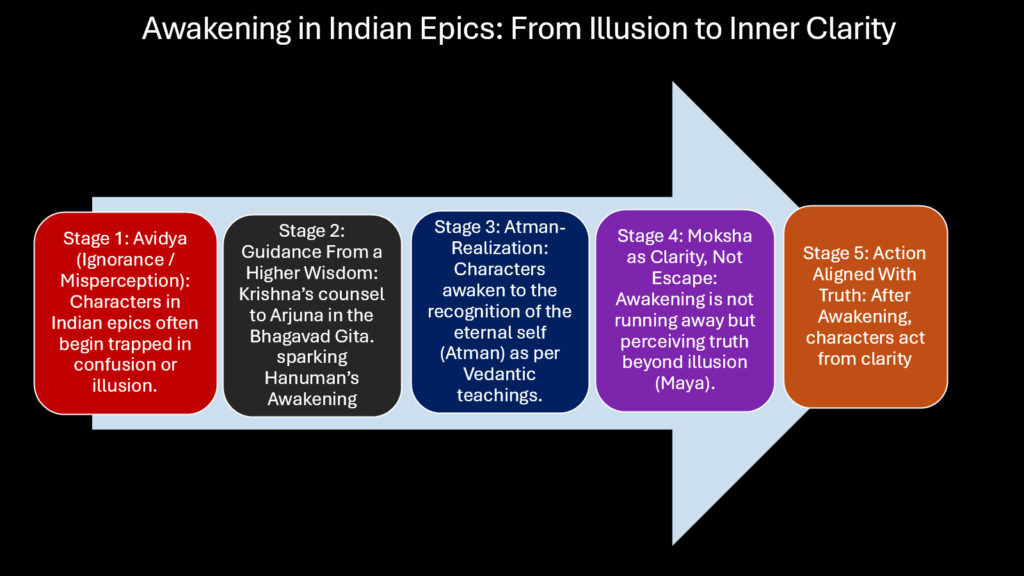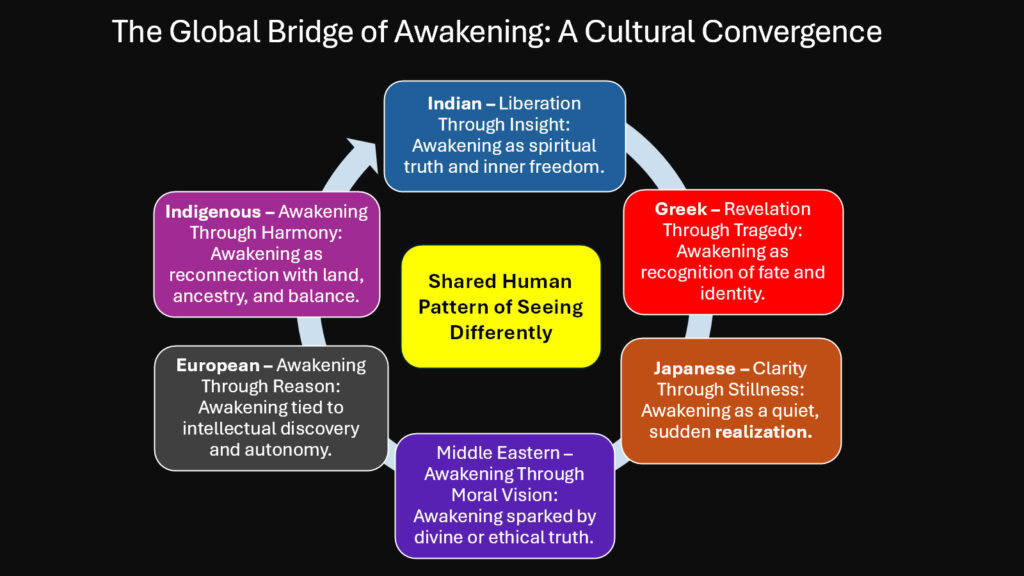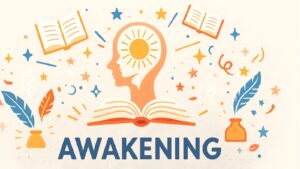Table of Contents
Introduction: Why Awakening Stories Shape Every Culture

A young warrior stands frozen on a battlefield, suddenly unable to fight his own kin. A wanderer returns home after years abroad only to see his kingdom with entirely new eyes. A monk sits beneath a tree when understanding strikes like lightning through still air. These moments share something fundamental. They represent Awakening, the instant when a character’s perception shatters and reforms into something truer than before.
Awakening stands among the most ancient story archetypes humans have ever told. Every culture across history has crafted tales where protagonists break through layers of misunderstanding to glimpse reality as it actually exists. This archetype does not rely on external conquest or material gain. Instead, it turns inward, focusing on the transformation of awareness itself. The character who awakens sees the same world through completely different eyes, and that shift in vision changes everything that follows.
What makes the Awakening archetype universal is its connection to human consciousness. We all experience moments when illusions collapse and truth emerges. Storytellers recognized this psychological reality thousands of years ago and built narratives around it. Whether in ancient Sanskrit epics, Greek tragedies, Japanese folktales, Middle Eastern parables, European novels, or Indigenous oral traditions, the pattern repeats. A character lives within a limited understanding of themselves or their world. Then something happens. The veil lifts. What they thought they knew crumbles, and a deeper truth takes its place.
Different cultures interpret this moment through their own philosophical and spiritual lenses. Some view Awakening as liberation from cosmic ignorance. Others see it as a tragic recognition of unbearable truths. Still others frame it as sudden clarity, moral realignment, intellectual courage, or return to natural balance. Yet beneath these variations lies a shared storytelling instinct. Humans need narratives that show transformation is possible, that awareness can expand, that we are not trapped forever in our current way of seeing.
This article explores six distinct cultural approaches to the Awakening archetype. Each tradition offers unique insights into how perception shifts, why truth matters, and what happens when a character finally sees clearly. Together, they reveal why Awakening remains one of the most powerful forces in global storytelling, capable of moving audiences across centuries and continents.
Awakening Compared to Other Story Archetypes
| Story Archetypes | Core Narrative Movement |
|---|---|
| Awakening | Character transforms through radical shift in perception and understanding of reality |
| Rags to Riches | Character rises from poverty or low status to wealth and social elevation |
| Quest For Meaning | Character searches for purpose through journey and discovers deeper significance |
| Voyage and Return | Character travels to unfamiliar realm and returns transformed by the experience |
| Tragedy | Character falls from grace through fatal flaws or unavoidable circumstances |
| Overcoming The Monster | Character confronts and defeats external threat to restore order and safety |
1. Greek Awakening Archetype: Anagnorisis and the Sudden Shock of Truth
Greek tragedy introduced Awakening as anagnorisis, the moment of devastating recognition. Aristotle identified this as crucial to dramatic structure, the instant when a character discovers their true identity or the real nature of their situation. Unlike Indian epics that treats this archetype as liberation, Greek epics often treats it as horror. The protagonist finally sees what they refused to acknowledge, and that knowledge destroys them. Truth becomes both revelation and punishment, offering no comfort or escape.
Oedipus Rex stands as the archetypal example. Oedipus spends the entire play pursuing the truth with admirable determination. He vows to find the murderer polluting Thebes, never suspecting he himself killed his father and married his mother. Each investigation brings him closer to unbearable knowledge. When recognition finally strikes, the Awakening proves catastrophic. Oedipus realizes his entire life was built on ignorance. The truth he sought so passionately becomes the instrument of his downfall. He blinds himself, transforming physical sight into a metaphor for the vision he finally gained too late.
The Odyssey presents a different shade of Greek revelation. When Odysseus finally returns to Ithaca after twenty years, he finds his palace overrun with suitors exploiting his absence. He enters disguised as a beggar, observing who remained loyal and who betrayed his household. The suitors fail to recognize him, blinded by their assumptions about power and status. Odysseus awakens to the truth of his situation gradually, gathering information before revealing himself. The moment of recognition, when he strings his bow and declares his identity, transforms the dynamic completely. Those who failed to see him clearly pay with their lives.
The Iliad explores revelation through Achilles. When his beloved Patroclus dies wearing Achilles’ armor, Achilles awakens to the consequences of his pride. His withdrawal from battle over wounded honor led directly to his companion’s death. This recognition transforms his rage from petulant to purposeful, though it ultimately seals his fate. Later, when Priam comes begging for Hector’s body, Achilles awakens again to their shared humanity. He sees his own father in the grieving king and grants mercy.
Greek narratives treat Awakening as emotionally intense and structurally pivotal. The moment divides the story into before and after. Once characters see truth, they cannot return to comfortable ignorance. Recognition reshapes everything, often with tragic consequences that flow inevitably from what was finally understood.
Greek Awakening Through Tragic Recognition
| Elements | Expression in Greek Drama |
|---|---|
| Nature of Truth | Hidden reality emerges through investigation and reveals painful facts |
| Trigger for Awakening | Accumulated evidence forces character to confront what they denied |
| Character Transformation | From ignorance and confidence to knowledge and devastation |
| Ultimate Goal | Restoration of cosmic order through acknowledgment of truth |
| Role of Fate | Recognition reveals predetermined patterns character cannot escape |
| Lasting Impact | Knowledge destroys previous identity and forces new understanding |
2. Indian Awakening Archetype: Moksha, Insight, and Inner Liberation

Indian storytelling treats Awakening as the highest form of freedom. The concept of moksha, or liberation from the cycle of birth and death, sits at the heart of this tradition. Characters awaken not to gain something external but to shed the layers of maya, the cosmic illusion that obscures ultimate reality. This reveals the atman, the eternal self that exists beyond ego, body, and social identity. When a character grasps this truth, they experience profound inner liberation that no worldly power can grant or take away.
The Mahabharata provides one of the most powerful examples of this archetype. On the battlefield of Kurukshetra, Arjuna faces his cousins, teachers, and loved ones in opposing armies. Overwhelmed by grief and moral confusion, he refuses to fight. Lord Krishna then delivers the Bhagavad Gita, awakening Arjuna to deeper truths about duty, the eternal nature of the soul, and the illusion of death. Lord Krishna explains that the body perishes but the atman remains untouched. He reveals that clinging to outcomes creates suffering, while performing righteous action without attachment brings freedom. Arjuna’s Awakening transforms his paralysis into purposeful action grounded in spiritual understanding rather than worldly attachment.
The Ramayana offers another dimension through Lord Hanuman’s story. Initially unaware of his own divine powers, Lord Hanuman lives as an ordinary monkey. When Jambavan reminds him of his true nature and capabilities, Lord Hanuman awakens to his cosmic strength. He leaps across the ocean to Lanka, demonstrating that revelation unlocks dormant potential. His realization comes through remembrance rather than acquisition. He always possessed these powers, but those powers were hidden inside him.
This pattern reveals how Indian narratives frame Awakening as recognition rather than discovery. The truth was always present, but layers of confusion, attachment, and false identification concealed it. Characters awaken by seeing through appearances to grasp the unchanging reality beneath the flux of phenomena. This story archetype brings equanimity, wisdom, and freedom from the tyranny of desire and fear. It represents the ultimate goal of human existence within Hindu and Buddhist philosophical frameworks.
Indian Awakening in Sacred Narratives
| Awakening Element | Expression in Indian Epics |
|---|---|
| Nature of Truth | Eternal self exists beyond material appearances and social roles |
| Trigger for Awakening | Divine teaching reveals nature of reality and dissolves confusion |
| Character Transformation | From attachment and ignorance to detachment and wisdom |
| Ultimate Goal | Liberation from cycles of suffering and rebirth through understanding |
| Role of Teacher | Guru figure guides disciple toward self-realization and clarity |
| Lasting Impact | Character acts with purpose while remaining unattached to outcomes |
3. European Awakening Archetype: Enlightenment, Reason, and the Birth of the Self
European storytelling, particularly from the Renaissance onward, links Awakening with intellectual courage and self-determination. Characters awaken by questioning inherited assumptions and discovering truth through reason. This tradition values individual consciousness asserting itself against tradition, authority, and social pressure. The protagonist awakens by thinking for themselves, often at great personal cost.
Dante’s Divine Comedy presents Awakening as a journey from confusion to understanding. Opening in a dark forest where the straight way is lost, Dante must travel through Hell, Purgatory, and Paradise to comprehend the cosmic order. Each realm reveals truths about sin, redemption, and divine love. Dante awakens gradually through accumulated experience and philosophical insight. His final vision of God represents complete understanding that transcends words. The journey itself becomes the Awakening, each circle and conversation adding layers of clarity.
William Shakespeare explored Awakening in numerous plays. King Lear awakens to the difference between genuine and false love only after losing everything. Stripped of power and exposed to nature’s fury, he finally sees which daughter truly cared for him. His madness paradoxically brings clarity. Hamlet awakens to the corrupt nature of Elsinor but struggles with how to respond. His Awakening involves recognizing moral decay while questioning the nature of action and justice itself.
Cervantes’ Don Quixote presents complex layers of Awakening. The protagonist begins by awakening from reality into delusion, convinced he is a knight errant. His madness creates its own logic that transforms windmills into giants and peasants into nobility. Near death, he awakens again, renouncing his fantasies and returning to sanity. Yet the novel questions which state represents true Awakening. Perhaps the mad knight who saw beauty and adventure everywhere grasped something the sane man lost.
European narratives often feature characters awakening to their own agency and capacity for self-creation. They discover that identity is not fixed by birth or tradition but can be shaped through choice and will. This Awakening emphasizes rational understanding, moral courage, and the revolutionary power of individual consciousness refusing to accept imposed limits.
European Awakening Through Rational Understanding
| Awakening Element | Expression in European Literature |
|---|---|
| Nature of Truth | Reality revealed through reason, questioning, and intellectual courage |
| Trigger for Awakening | Crisis forces character to examine assumptions and discover self |
| Character Transformation | From acceptance of tradition to assertion of individual understanding |
| Ultimate Goal | Self-determination and freedom through rational enlightenment |
| Role of Society | External pressure and convention must be resisted or transcended |
| Lasting Impact | Character claims agency and shapes identity through conscious choice |
4. Japanese Awakening Archetype: Satori and the Flash of Pure Awareness

Japanese storytelling approaches Awakening through satori, the Zen concept of sudden enlightenment. Unlike Greek tragedy’s dramatic intensity or Indian philosophy’s conceptual framework, the Japanese approach is to emphasize quiet immediacy. The moment arrives without fanfare. A character simply sees clearly, without the mediation of thought or emotion. This clarity requires no explanation or justification. It exists as pure awareness, direct and unfiltered.
Zen tradition contains countless stories of monks achieving satori through seemingly mundane events. A master strikes a student with a bamboo stick. The sharp sound cuts through mental chatter, and the student awakens. Another hears a pebble strike bamboo and suddenly understands. These moments share a quality of spontaneous recognition that bypasses intellectual analysis. The Awakening does not come from accumulating knowledge but from dropping all concepts and experiencing reality without interpretation.
The Heike Monogatari, chronicling the rise and fall of the Taira clan, weaves Buddhist themes of impermanence throughout its narrative. Warriors awaken to the transient nature of power and glory as they witness the clan’s destruction. The opening lines speak of temple bells echoing impermanence, reminding listeners that all things pass. Characters who grasp this truth find peace even in defeat. Those who cling to status and victory suffer when circumstances inevitably change. The Awakening here involves accepting rather than resisting the flow of existence.
Japanese folktales often feature characters awakening through encounters with nature. A fisherman saves a turtle and later visits an underwater palace where time moves differently. When he returns, centuries have passed. This experience awakens him to the relative nature of reality and the limits of human perception. A bamboo cutter discovers a tiny princess inside a stalk and raises her. When she must return to the moon, he awakens to the bittersweet nature of beauty and attachment. These stories present Awakening as gentle but complete, shifting perspective without violence.
The Japanese approach values simplicity and directness. Awakening does not require elaborate philosophy or dramatic revelation. It arrives in the space between thoughts, in the silence after sound, in the stillness beneath action. Characters awaken by letting go of concepts rather than grasping new ones. This tradition suggests that clarity was always present, merely obscured by mental noise.
Japanese Awakening Through Zen Clarity
| Elements | Expression in Japanese Narrative |
|---|---|
| Nature of Truth | Direct perception of reality without conceptual interference |
| Trigger for Awakening | Ordinary moment becomes gateway when mind stops grasping |
| Character Transformation | From conceptual thinking to immediate awareness of what is |
| Ultimate Goal | Liberation from suffering through acceptance of impermanence |
| Role of Teacher | Master creates conditions but student must awaken themselves |
| Lasting Impact | Character acts naturally without internal conflict or attachment |
5. Middle Eastern Awakening Archetype: Prophetic Vision and Moral Realignment
Middle Eastern storytelling frames Awakening as moral clarity received through divine or spiritual vision. Characters awaken when they perceive the ethical dimension of existence that was previously hidden. This recognition transforms their sense of responsibility and purpose. The Awakening carries weight because it connects individual consciousness to transcendent truth. Characters cannot ignore what they have seen. The vision demands response and commitment.
The Quran presents numerous accounts of prophetic Awakening. Moses encounters the burning bush and awakens to his mission of liberating the Israelites. Muhammad receives a revelation in the cave and awakens to his role as a messenger. These moments share a pattern of divine interruption that shatters ordinary consciousness. The prophet awakens to truths beyond personal interest or social convention. They see justice, compassion, and submission to divine will as fundamental realities that must guide human action.
The story of Jonah explores reluctant Awakening. Called to warn Nineveh of coming destruction, Jonah flees instead. After being swallowed by a great fish and cast onto shore, he finally accepts his mission. His Awakening comes through suffering that breaks his resistance. He realizes he cannot escape divine purpose. When Nineveh repents and God shows mercy, Jonah must awaken again to understand compassion beyond rigid judgment. His transformation involves multiple layers of recognition about duty, mercy, and the nature of divine will.
Persian poetry by Rumi and Hafiz treats Awakening as spiritual intoxication that reveals the beloved’s presence in all things. The lover awakens to unity beneath apparent separation. This mystical Awakening transforms ordinary perception into recognition of divine reality permeating existence. Characters move from seeing the world as a collection of separate objects to experiencing it as a manifestation of sacred presence.
Middle Eastern narratives connect Awakening to ethical transformation. Characters do not merely gain knowledge but assume responsibility for living according to what they now understand. The vision demands action. Prophets must warn their people. Mystics must embody love. Ordinary individuals must choose justice over convenience. Awakening becomes inseparable from moral commitment and righteous conduct.
Middle Eastern Awakening Through Prophetic Vision
| Elements | Expression in Middle Eastern Tradition |
|---|---|
| Nature of Truth | Moral and spiritual reality revealed through divine communication |
| Trigger for Awakening | Sacred vision interrupts ordinary consciousness and demands attention |
| Character Transformation | From self-interest to alignment with divine will and justice |
| Ultimate Goal | Living in accordance with revealed truth and ethical principles |
| Role of Divine | God or sacred reality initiates Awakening through direct intervention |
| Lasting Impact | Character dedicates life to fulfilling moral purpose shown in vision |
6. Indigenous Awakening Archetype: Nature, Memory, and Returning to Balance
Indigenous storytelling across cultures presents Awakening as reconnection with land, ancestry, and communal harmony. Characters awaken by remembering their relationship to the natural world and their place within the web of kinship. This Awakening heals rather than disrupts. It restores the balance that was lost when the character became separated from their true context. The individual awakens to their role within a larger living system.
Many Indigenous traditions feature vision quests where young people seek Awakening through isolation, fasting, and prayer. The seeker ventures into the wilderness alone, opening themselves to guidance from spirits, animals, or the land itself. When vision comes, it reveals their purpose and gifts. This Awakening connects personal identity to communal need. The vision shows how the individual serves the whole. Characters return with new names, responsibilities, and understanding of their place in the circle of life.
Australian Aboriginal Dreamtime stories present Awakening as remembering the sacred patterns established by ancestral beings. The land itself carries memory. Characters awaken by connecting to these deeper stories that shape reality. A person lost in the desert might receive guidance from ancestors. Animals appear as teachers, revealing lessons about survival and reciprocity. Awakening involves recognizing that the visible world is inseparable from the spiritual dimension that animates it.
North American Indigenous narratives often feature characters who have forgotten their connection to the natural world. They may have adopted destructive practices or lost traditional knowledge. Through encounters with animals, ceremonies, or elder guidance, they awaken to the consequences of imbalance. A hunter who takes without gratitude faces starvation until he learns respect. A community ignoring seasonal wisdom suffers until it remembers old ways. These stories present Awakening as a return rather than a progression, a restoration of harmony that was always available.
Indigenous Awakening emphasizes relationship over individual achievement. Characters awaken to their responsibilities toward other beings, future generations, and the land that sustains all life. This consciousness transformation is ecological and communal. The individual sees clearly how their actions ripple through the network of relations. Awakening brings humility, gratitude, and commitment to maintaining balance.
Indigenous Awakening Through Relational Awareness
| Awakening Element | Expression in Indigenous Traditions |
|---|---|
| Nature of Truth | Reality consists of sacred relationships between all living beings |
| Trigger for Awakening | Vision, ceremony, or natural encounter reveals interconnection |
| Character Transformation | From separation and imbalance to recognition of kinship networks |
| Ultimate Goal | Restoration of harmony and fulfillment of role in community |
| Role of Ancestors | Guidance from elders and spirits connects present to sacred patterns |
| Lasting Impact | Character acts with awareness of responsibility to all relations |
Conclusion: The Shared Thread Behind All Cultural Awakenings

Six distinct traditions, six different interpretations of the same fundamental transformation. Indian storytelling presents Awakening as liberation from cosmic illusion. Greek drama frames it as a tragic recognition of an unbearable truth. Japanese narrative emphasizes sudden clarity without conceptual mediation. Middle Eastern tradition connects it to prophetic vision and moral responsibility. European literature links it to rational understanding and self-determination. Indigenous stories treat it as a restoration of relational balance. Each culture shapes the archetype according to its own philosophical assumptions and spiritual values.
Yet beneath this diversity runs a shared current. Every tradition recognizes that human consciousness can transform. We can see differently than we did before. The veil of ignorance, denial, or limited perception can lift. When it does, the character’s entire relationship to reality shifts. What seemed solid becomes an illusion. What seemed impossible becomes necessary. What seemed separate reveals a connection. This transformation of awareness represents one of the most profound experiences storytelling can capture.
Awakening remains powerful because it reflects genuine psychological and spiritual possibilities. We know from our own lives that perspective can radically change. A single conversation, experience, or moment of reflection can reorganize our entire understanding. Stories that dramatize this process resonate across cultures because they speak to the universal human capacity for growth and transformation. They suggest we are not trapped in our current way of seeing. Deeper truth waits to be recognized.
The awakening archetype also carries philosophical weight. It implies that appearances deceive. Surface reality obscures something more fundamental. Whether that truth is cosmic unity, tragic fate, impermanence, divine will, rational order, or sacred relationship depends on cultural context. But every tradition agrees that ordinary consciousness misses something essential. This story archetype promises that clarity is possible and necessary.
Awakening endures in global storytelling because it addresses fundamental questions about human existence. Can we escape our limitations? Is truth accessible? Does awareness matter more than action? Can seeing clearly change everything? Every culture answers differently, but every culture keeps asking. The Awakening archetype provides structure for exploring these perennial concerns.
Awakening Across Cultural Boundaries
| Cultural Tradition | Core Understanding of Awakening |
|---|---|
| Indian | Liberation from illusion through recognition of eternal self |
| Greek | Tragic recognition that reveals unbearable truth and transforms fate |
| Japanese | Sudden clarity arising from direct perception without conceptual mediation |
| Middle Eastern | Prophetic vision that demands moral response and righteous action |
| European | Rational understanding that creates self-awareness and individual agency |
| Indigenous | Relational awareness that restores balance and remembers sacred connections |




